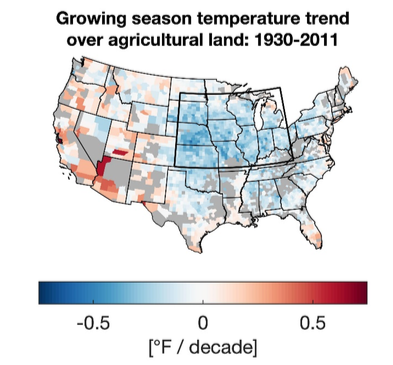HANOVER, N.H. – Oct. 24, 2019 – The global average temperature has increased 1.4 degrees Fahrenheit over the last 100 years. In contrast, the Corn Belt of the U.S., one of the most agriculturally productive regions of the world, has experienced a decrease in temperatures in the summer during the growing season. Known as the “U.S. warming hole,” this anomalous cooling phenomenon, which occurred in tandem with increasing rainfall, was responsible for boosting corn yields by 5 to 10 percent per year, according to a Dartmouth-led study published in Environmental Research Letters. The study is one of the first to investigate the impacts of the warming hole on agriculture.
Image  |
| U.S. map of growing season average temperature from 1930 to 2011 over agricultural land with a box drawn around the Corn Belt. Growing season based on USDA planting and harvesting data, and runs approximately from early May to September. Figure by Trevor F. Partridge. |
Image  |
| Predicted corn yield benefit from U.S. warming hole. Figure by Trevor F. Partridge. |
Most of the increases in corn yield over the 20th century have resulted from advancements in crop genetics, increased fertilizer application and improved agricultural practices. “If however, the U.S. warming hole had not existed, corn yields for the average county in the central U.S. would have been approximately 10 percent lower per year,” explained lead author Trevor F. Partridge, a graduate student in the department of earth sciences at Dartmouth. “This benefit of a 10 percent higher corn yield translates to roughly $1.5 billion per year in additional value. Our results underscore how the central U.S. has been relatively sheltered from the impacts of climate change,” he added. ($1.5 billion calculation uses historical market value data from Iowa State University Extension and Outreach and U.S. corn production data from the U.S. Department of Agriculture).
To examine the relationship between corn yields and climate, the researchers used over 70 years of historical climate and yield data, machine learning algorithms, and biophysical crop models to simulate corn yields under multiple climate scenarios. The scenarios included historical climate with the warming hole, where temperatures dropped in the late-1950s and rainfall increased, and a counterfactual climate scenario where temperature and rainfall changes associated with the warming hole were removed.
The researchers found that cooler temperatures associated with the warming hole were responsible for most of the increased U.S. corn yield— 62 percent of the simulated yield increase, whereas, summer precipitation was responsible for the remaining 38 percent of the simulated yield increase. The lower temperatures allowed corn to mature slower. Extended maturation time allows for more grain to accumulate on a corn plant, increasing yields. The cooler temperatures and increased rainfall associated with the warming hole meant that corn was less likely to experience heat and drought stress during the growing cycle, also increasing yields.
The findings demonstrated that North Dakota and South Dakota, and western Minnesota benefited most from the U.S. warming hole, as counties in these states had yield differences of up to 24 percent based on the study’s simulations. For Greene County, Illinois, if the warming hole did not exist, corn yield would have decreased by an average of 26 percent, and maximum temperatures would have increased by an average of 1.8 degrees Fahrenheit.
Image  |
| Effect of removing the warming hole on maximum temperature and corresponding impact on corn yield for Greene County, Illinois. Figure provided by Trevor F. Partridge. |
The authors emphasize that the U.S. warming hole is an anomaly, one of two places in the world that has not warmed significantly, and that the last five years (2014-2018) have, globally averaged, been the hottest years on record. These findings should not be misinterpreted as evidence against the overwhelming scientific consensus that climate change is real and caused by humans. Climate projections suggest that by the mid-21st century, temperatures in the central U.S. will increase by up to 4.1 degrees Fahrenheit, and summer precipitation may decrease by approximately 10 percent.
“The boost in yield that the Corn Belt has enjoyed from the effects of the warming hole is likely to diminish in the future. While this region has been an anomaly for the past half century, we need to be prepared for the challenges associated with climate change,” said co-author Jonathan Winter, an assistant professor of geography and principal investigator of the Applied Hydroclimatology Group at Dartmouth.
Winter is available for comment at: jwinter@dartmouth.edu. In addition to Trevor F. Partridge and Jonathan Winter at Dartmouth, this study has four Michigan State University co-authors— Lin Liu, Anthony Kendall, Bruno Basso, and David Hyndman.

